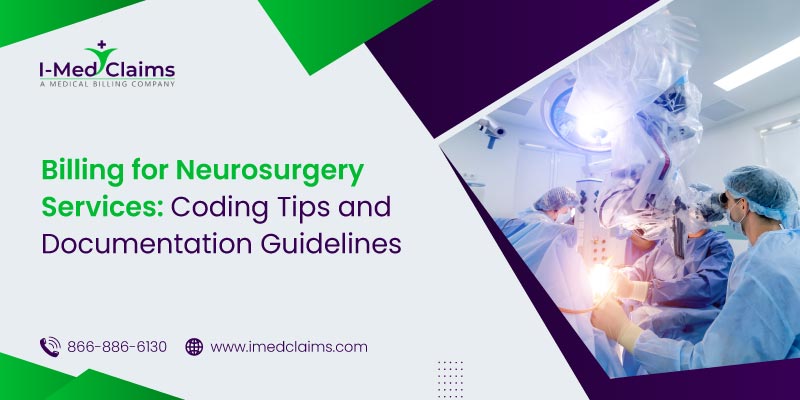Neurosurgery is a complex medical speciality that requires precision and expertise. As a result, proper coding and documentation are crucial when it comes to billing for neurosurgery services. In this blog post, we will provide you with essential tips to help streamline the billing for neurosurgery procedures.
Understanding Billing for Neurosurgery Services
Billing for neurosurgery services forms the backbone of efficient reimbursement processes in healthcare. It encompasses the vital task of submitting accurate claims to insurance entities for the services rendered by medical professionals. These claims are distinguished by specific billing codes rooted in the established Current Procedural Terminology (CPT) system. Managed by the American Medical Association (AMA), the CPT system universally guides healthcare providers inappropriately billing for their services across the United States.
A robust grasp of neurosurgery billing codes and their correct utilization is imperative. Incorrect code usage can trigger setbacks such as delayed payments or claim denials, ultimately impacting the financial health of medical practices. Moreover, stringent adherence to the regulatory standards and guidelines set by the Centers for Medicare and Medicaid Services (CMS) and private insurance companies is essential. By aligning with these guidelines, healthcare providers can streamline their billing processes, ensure accurate reimbursement, and maintain compliance with industry norms.
Challenges in Billing for Neurosurgery Services
Here are the following neurosurgery billing challenges faced by healthcare professionals:
Navigating Complexity: Managing billing for neurosurgery services is intricate due to the process’s complexity and evolving regulations.
Compliance Hurdles: Ensuring adherence to insurance and government rules. Notably, CMS poses a significant challenge, with potential penalties for non-compliance.
Dynamic Codes and Rules: Keeping pace with ever-changing neurosurgery billing codes and rules demands ongoing education to avoid errors and revenue loss.
Neurosurgery Revenue Cycle Management Steps
Step 1: Insurance Verification
Verify patient insurance and eligibility to understand coverage details and potential out-of-pocket expenses.
Step 2: Service and Charge Documentation
Document patient visits meticulously, capturing decisions, tests, procedures, and time spent for accurate billing.
Step 3: Claims Submission
Translate medical documentation into CPT and ICD-10 codes, creating and submitting claims to insurers.
Step 4: Payment Process
Insurers review and process claims, issuing payments for approved claims and addressing denials through appeals.
Step 5: Financial Reporting and Compliance
Generate reports to analyze the practice’s financial health, identify improvement areas, and adhere to regulatory data requirements.
Tips To Optimize Billing for Neurosurgery Services
When billing for neurosurgery services, it’s important to emphasize the significance of accurate documentation and coding practices. Billing errors can occur without meticulous attention to detail, leading to claim denials, delayed reimbursements, and potential compliance issues. Here are the following tips to help you get started:
Accurate Coding is Key
Accurate coding is essential to ensure correct billing for neurosurgery services. Here are some essential tips for streamlining the coding process:
- Familiarize yourself with the Current Procedural Terminology (CPT) codes specific to neurosurgery procedures. These codes are regularly updated, so staying up-to-date with any changes is crucial.
- Ensure that your CPT codes align with the specific neurosurgery procedure performed. Be detailed in your coding to reflect the complexity and intricacy of the system accurately.
- Utilize modifiers when necessary to provide additional information about the neurosurgery service provided. Common modifiers include -22 (increased procedural services) and -59 (distinct procedural service).
Comprehensive Documentation is a Must
Accurate and comprehensive documentation is crucial for successful billing and reimbursement. Here are some essential documentation guidelines to follow:
- Identify the patient’s symptoms, medical history, and diagnosis leading to the decision for neurosurgery. This information helps establish medical necessity.
- Document the detailed neurosurgical procedure, including any anatomical references, surgical techniques utilized, and targeted areas.
- Include evidence of pre-operative and post-operative care provided to the patient, such as consultations, imaging studies, and any necessary follow-up visits.
- Document any complications or unexpected events during the neurosurgery procedure and the actions taken to address them.
Stay Informed About Coding and Billing Regulations
The medical coding and billing world is continuously evolving, and it’s crucial to stay informed about any regulatory changes specific to neurosurgery services. Here are some tips to help you stay informed:
- Regularly review official coding guidelines and updates provided by the Centers for Medicare and Medicaid Services (CMS) and the American Medical Association (AMA).
- Attend educational workshops, conferences, and webinars to enhance your neurosurgery coding and billing knowledge.
- Establish effective communication channels with fellow neurosurgeons, coding professionals, and medical billing experts to exchange information and share best practices.
Internal Auditing
To help streamline the billing process, consider implementing a robust internal auditing system:
- Regularly review coded claims for accuracy, ensure alignment with documentation guidelines, and address any coding discrepancies promptly.
- This proactive approach will help optimize revenue cycles and promote compliance with billing regulations and standards.
- Regular auditing can uncover areas for improvement and allow for ongoing education and training to enhance the billing accuracy of neurosurgery services.
By following these coding tips and documentation guidelines, you’ll be better equipped to handle billing for neurosurgery services accurately. Remember, accurate coding and comprehensive documentation are the keys to successful reimbursement and compliance.


